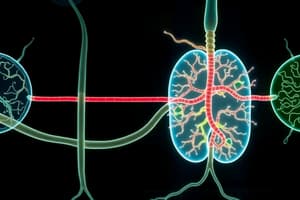Podcast
Questions and Answers
Explain the difference between fermentation and cellular respiration.
Explain the difference between fermentation and cellular respiration.
Fermentation is the partial degradation of sugars or other organic fuel without oxygen while cellular respiration uses oxygen.
Give the formula (with names) for the catabolic degradation of glucose by cellular respiration.
Give the formula (with names) for the catabolic degradation of glucose by cellular respiration.
C₆H₁₂O₆ + 6 O₂ → 6 CO₂ + 6 H₂O + Energy (ATP + Heat) or Glucose + Oxygen → Carbon Dioxide + Water + Energy (ATP + Heat)
What is the difference between oxidation and reduction?
What is the difference between oxidation and reduction?
Oxidation is the loss of electrons from one substance and reduction is the gain of electrons to another substance.
Which component is oxidized and which component is reduced in the reaction Xe⁻ + Y → X + Ye⁻?
Which component is oxidized and which component is reduced in the reaction Xe⁻ + Y → X + Ye⁻?
When compounds lose electrons, they ________________ energy; when compounds gain electrons, they _______________ energy.
When compounds lose electrons, they ________________ energy; when compounds gain electrons, they _______________ energy.
What electron carrier is hydrogen transferred to first?
What electron carrier is hydrogen transferred to first?
What are coenzymes?
What are coenzymes?
Describe what happens when NAD⁺ is reduced. What enzyme is involved?
Describe what happens when NAD⁺ is reduced. What enzyme is involved?
What is the function of the electron transport chain in cellular respiration?
What is the function of the electron transport chain in cellular respiration?
Where are electron transport chains found in eukaryotic cells?
Where are electron transport chains found in eukaryotic cells?
Where are electron transport chains found in prokaryotic cells?
Where are electron transport chains found in prokaryotic cells?
What strongly electronegative atom is the final electron acceptor?
What strongly electronegative atom is the final electron acceptor?
What are the three steps of the conversion process in the citric acid cycle?
What are the three steps of the conversion process in the citric acid cycle?
How many NADHs are formed in the citric acid cycle?
How many NADHs are formed in the citric acid cycle?
How many times does the citric acid cycle occur for each molecule of glucose?
How many times does the citric acid cycle occur for each molecule of glucose?
How many ATPs are formed in the citric acid cycle?
How many ATPs are formed in the citric acid cycle?
How many FADH₂ have been formed in the citric acid cycle?
How many FADH₂ have been formed in the citric acid cycle?
How many total carbons are lost as pyruvate is oxidized in the citric acid cycle?
How many total carbons are lost as pyruvate is oxidized in the citric acid cycle?
The oxidation of pyruvate accounts for two additional reduced __________ molecules and two molecules of CO₂.
The oxidation of pyruvate accounts for two additional reduced __________ molecules and two molecules of CO₂.
Explain what has happened to each of the 6 carbons found in the original glucose molecule.
Explain what has happened to each of the 6 carbons found in the original glucose molecule.
Why is oxygen the ultimate electron acceptor?
Why is oxygen the ultimate electron acceptor?
Oxygen stabilizes the electrons by combining with two hydrogen ions to form what compound?
Oxygen stabilizes the electrons by combining with two hydrogen ions to form what compound?
The two electron carrier molecules that feed electrons into the electron transport system are __________________ and ____________.
The two electron carrier molecules that feed electrons into the electron transport system are __________________ and ____________.
Explain how ATP synthase uses the flow of hydrogen ions to produce ATP.
Explain how ATP synthase uses the flow of hydrogen ions to produce ATP.
What is the role of the electron transport chain in forming the H⁺ gradient across the inner mitochondrial membrane?
What is the role of the electron transport chain in forming the H⁺ gradient across the inner mitochondrial membrane?
Two key terms are chemiosmosis and proton-motive force. Relate both of these terms to the process of oxidative phosphorylation.
Two key terms are chemiosmosis and proton-motive force. Relate both of these terms to the process of oxidative phosphorylation.
Each NADH can form a maximum of ______________ ATP molecules. Each FADH, which donates electrons that activate only two proton pumps, makes ______________ ATP molecules.
Each NADH can form a maximum of ______________ ATP molecules. Each FADH, which donates electrons that activate only two proton pumps, makes ______________ ATP molecules.
Why is the total count 36 or 38 ATP molecules rather than a specific number?
Why is the total count 36 or 38 ATP molecules rather than a specific number?
Fermentation allows for production of ATP without using either ____________ or any ____________.
Fermentation allows for production of ATP without using either ____________ or any ____________.
What is the electron acceptor in fermentation?
What is the electron acceptor in fermentation?
Explain the process of alcohol fermentation starting with glucose and yielding ethanol, and describe how NAD⁺ is recycled.
Explain the process of alcohol fermentation starting with glucose and yielding ethanol, and describe how NAD⁺ is recycled.
Explain the process of lactic acid fermentation starting with glucose and yielding lactate, and describe how NAD⁺ is recycled.
Explain the process of lactic acid fermentation starting with glucose and yielding lactate, and describe how NAD⁺ is recycled.
Why is pyruvate a key juncture in metabolism?
Why is pyruvate a key juncture in metabolism?
What three organic macromolecules are often utilized to make ATP by cellular respiration?
What three organic macromolecules are often utilized to make ATP by cellular respiration?
Explain the difference in energy usage between the catabolic reactions of cellular respiration and anabolic pathways of biosynthesis.
Explain the difference in energy usage between the catabolic reactions of cellular respiration and anabolic pathways of biosynthesis.
Explain how AMP stimulates cellular respiration while citrate and ATP inhibit it.
Explain how AMP stimulates cellular respiration while citrate and ATP inhibit it.
Explain how phosphofructokinase acts as a control point in cellular respiration.
Explain how phosphofructokinase acts as a control point in cellular respiration.
Is NAD⁺ oxidized or reduced? Lower or higher potential energy? Is NADH oxidized or reduced? Lower or higher potential energy?
Is NAD⁺ oxidized or reduced? Lower or higher potential energy? Is NADH oxidized or reduced? Lower or higher potential energy?
Explain how the electron transport chain is utilized in oxidative phosphorylation.
Explain how the electron transport chain is utilized in oxidative phosphorylation.
What is the meaning of glycolysis? What occurs in this step of cellular respiration?
What is the meaning of glycolysis? What occurs in this step of cellular respiration?
The starting point of glycolysis is the six-carbon sugar ___________, and the ending products are two ______________-carbon molecules of pyruvate.
The starting point of glycolysis is the six-carbon sugar ___________, and the ending products are two ______________-carbon molecules of pyruvate.
What two stages can glycolysis be divided into?
What two stages can glycolysis be divided into?
In the energy investment phase, which two steps use ATP? In the energy payoff phase, which two steps produce ATP and which step forms NADH?
In the energy investment phase, which two steps use ATP? In the energy payoff phase, which two steps produce ATP and which step forms NADH?
Notice that glycolysis occurs in the __________ of the cell. Is oxygen required?
Notice that glycolysis occurs in the __________ of the cell. Is oxygen required?
Each member of the electron transport chain is lower in free __________ than the preceding member of the chain, but higher in _________. The molecule at zero free energy, which is _____________, is lowest of all the molecules in free energy and highest in electronegativity.
Each member of the electron transport chain is lower in free __________ than the preceding member of the chain, but higher in _________. The molecule at zero free energy, which is _____________, is lowest of all the molecules in free energy and highest in electronegativity.
Flashcards are hidden until you start studying
Study Notes
Fermentation vs Cellular Respiration
- Fermentation partially degrades organic fuels without oxygen.
- Cellular respiration fully degrades glucose using oxygen.
Cellular Respiration Process
- Formula: Glucose + Oxygen → Carbon Dioxide + Water + Energy (ATP + Heat).
- Involves redox reactions: oxidation (loss of electrons) and reduction (gain of electrons).
Oxidation and Reduction
- Oxidation: loss of electrons from one substance, while reduction involves gain to another.
- Example reaction: Xe⁻ is oxidized while Y is reduced.
Electron Carriers
- First electron carrier for hydrogen is NAD⁺.
- NAD⁺ is reduced to NADH when it gains electrons, aided by dehydrogenase enzymes.
- FADH₂ also participates in electron transport.
Citric Acid Cycle (Krebs Cycle)
- Occurs after glycolysis, involving pyruvate conversion and oxidation.
- Outputs: 3 NADH, 1 FADH₂, 1 ATP, and 2 CO₂ per cycle.
- Cycle runs twice per glucose, totaling 6 NADH and 2 FADH₂.
Electron Transport Chain
- Located in the inner mitochondrial membrane in eukaryotes; prokaryotes use their plasma membrane.
- Oxygen is the final electron acceptor due to its high electronegativity.
- Creates a proton gradient; ATP synthase utilizes this to produce ATP.
ATP Production
- NADH can yield up to 3 ATP, whereas FADH₂ yields up to 2 ATP.
- Total ATP yield varies due to inefficiencies and shuttle mechanisms, estimated at 36-38 ATP.
Fermentation Processes
- Involves organic molecules as electron acceptors.
- Alcohol fermentation produces ethanol and recycles NAD⁺ from NADH.
- Lactic acid fermentation forms lactate without CO₂ release.
Energy Utilization
- Catabolic pathways generate energy; anabolic pathways consume energy.
- AMP stimulates respiration, while ATP and citrate inhibit it.
Glycolysis Overview
- Means "sugar splitting"; glucose is converted to pyruvate.
- Divided into energy investment (ATP is consumed) and energy payoff phases (ATP and NADH generated).
- Occurs in cellular cytosol; does not require oxygen.
Key Terms and Concepts
- Phosphofructokinase acts as a control point in glycolysis; it is an allosteric enzyme.
- Each electron transport chain member has lower free energy than the previous; oxygen is the terminal electron acceptor.
- Pyruvate oxidation represents a critical juncture for metabolic pathways, producing NADH and CO₂.
Studying That Suits You
Use AI to generate personalized quizzes and flashcards to suit your learning preferences.




